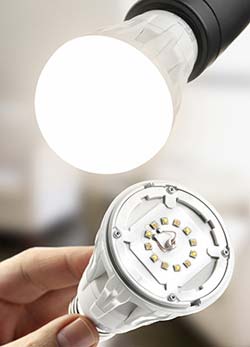LED Concept for Efficient, Warm-white Light

Until now, it was almost impossible to achieve high efficiency with a warm-white LED light similar to that of an incandescent lamp, because the warmer the white light was, the lower the luminous efficiency became.
And energy efficiency dropped even lower if you also wanted to have very good color rendering properties. Now there’s ‘Brilliant Mix’, a special combination of white and red LEDs that boosts the efficiency of warm-white LED lamps by almost one-third. What’s more, the LED light’s color rendering value of over 90 even surpasses that of energy-saving bulbs.
These LEDs would be particularly attractive for department and clothing stores, where customers need to judge colors and should feel comfortable. A white LED usually consists of a blue-glowing chip coated with a layer of phosphor. Excited by the blue light, the phosphor layer glows yellow. The superimposition of the two colors appears as a cold shade of white to viewers. Warm shades of white are created with the help of reddish converters, which, however, absorb light. Because most LED lamps consist of several light-emitting diodes, the ‘Brilliant Mix’ concept combines very efficient white LEDs using a special type of phosphor with red LEDs.
This creates a warm-white light with an efficiency of over 100 lumens per watt (lm/W). An energy-saving bulb has a luminous efficiency of about 60 lm/W. The new concept achieves high efficiency with the help of improved chip technology, a more efficient converter material, and other factors.
A light source’s color rendering properties are dependent on its frequency spectrum — only colors that are emitted are also reflected. LEDs using the Brilliant Mix concept emit light over a broad spectrum, which is why they have very good color rendering properties. ‘Brilliant Mix’ even achieves a color rendering index value of 98 for the especially critical flesh tones. This result is almost identical to the reference value for daylight, which is 100. The ratio of red to white LEDs makes it possible to create light with a color temperature of 2,700 to 4,000 Kelvin (the former value corresponds to that of an incandescent lamp).
Osram Opto Semiconductors is a subsidiary of Osram, which is owned by Siemens. Highly efficient LED lighting forms part of the Siemens Environmental Portfolio, which generated around €28 billion in sales for the company in fiscal year 2010.
Media Contact
More Information:
http://www.siemens.com/innovationnewsAll latest news from the category: Power and Electrical Engineering
This topic covers issues related to energy generation, conversion, transportation and consumption and how the industry is addressing the challenge of energy efficiency in general.
innovations-report provides in-depth and informative reports and articles on subjects ranging from wind energy, fuel cell technology, solar energy, geothermal energy, petroleum, gas, nuclear engineering, alternative energy and energy efficiency to fusion, hydrogen and superconductor technologies.
Newest articles

Microscopic basis of a new form of quantum magnetism
Not all magnets are the same. When we think of magnetism, we often think of magnets that stick to a refrigerator’s door. For these types of magnets, the electronic interactions…

An epigenome editing toolkit to dissect the mechanisms of gene regulation
A study from the Hackett group at EMBL Rome led to the development of a powerful epigenetic editing technology, which unlocks the ability to precisely program chromatin modifications. Understanding how…

NASA selects UF mission to better track the Earth’s water and ice
NASA has selected a team of University of Florida aerospace engineers to pursue a groundbreaking $12 million mission aimed at improving the way we track changes in Earth’s structures, such…





















